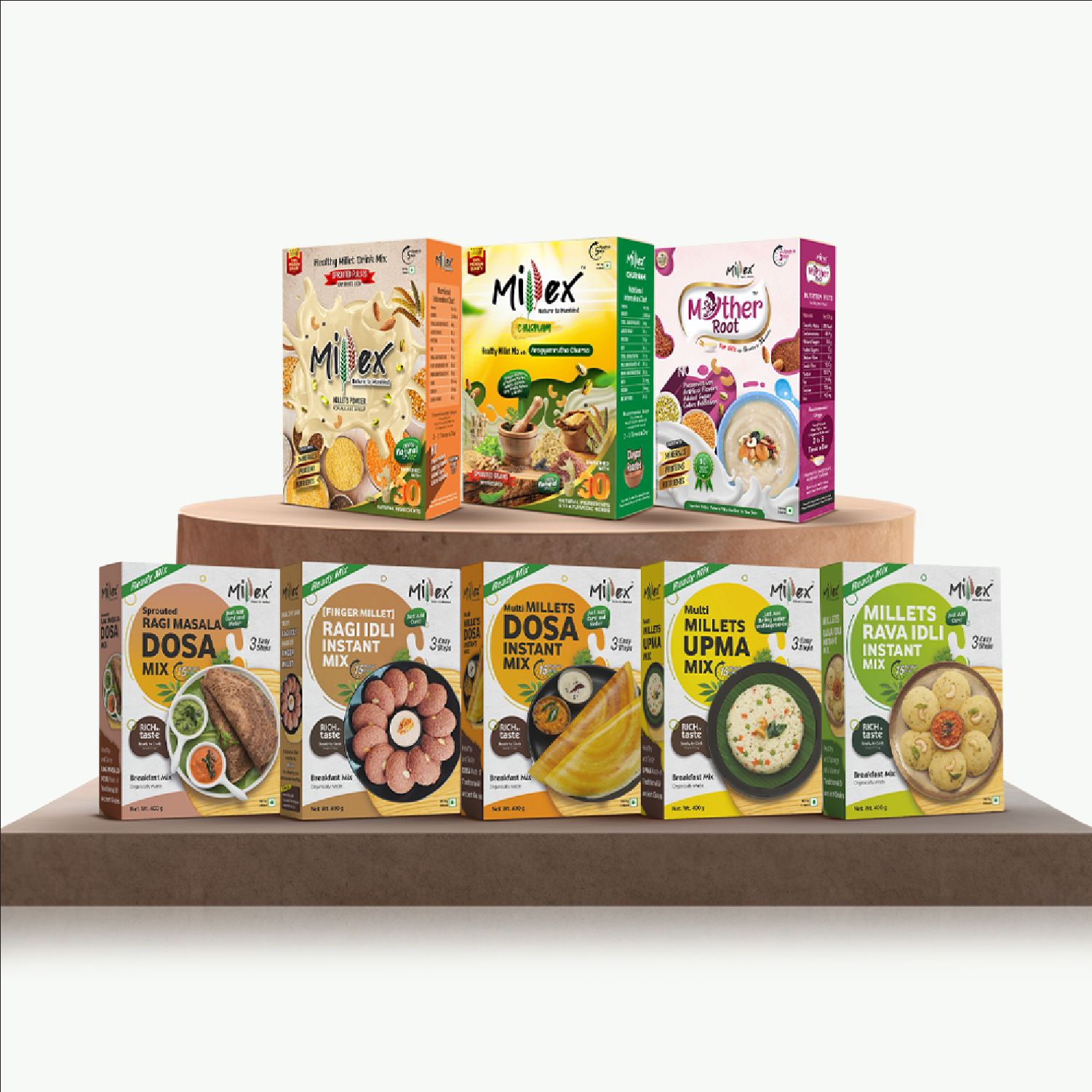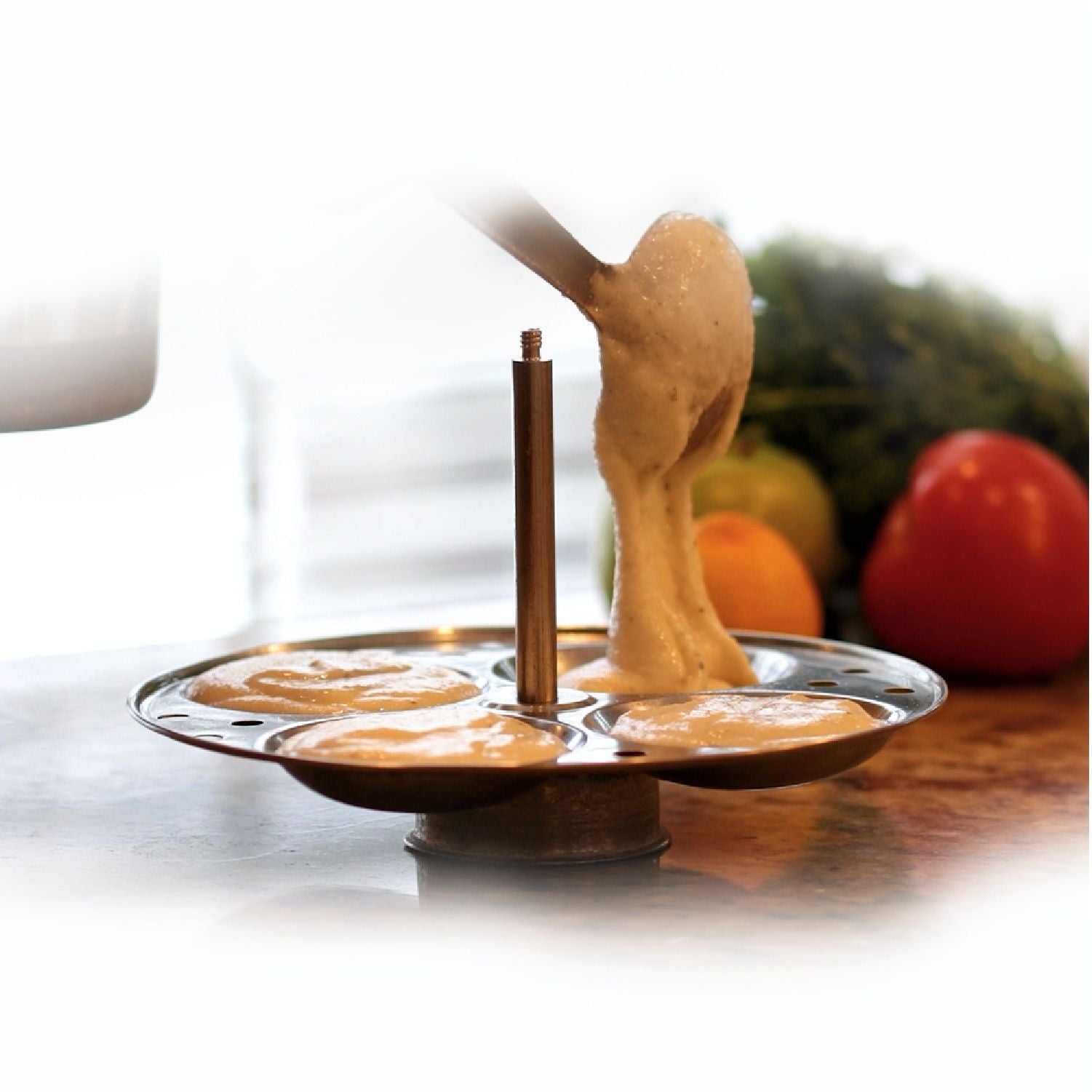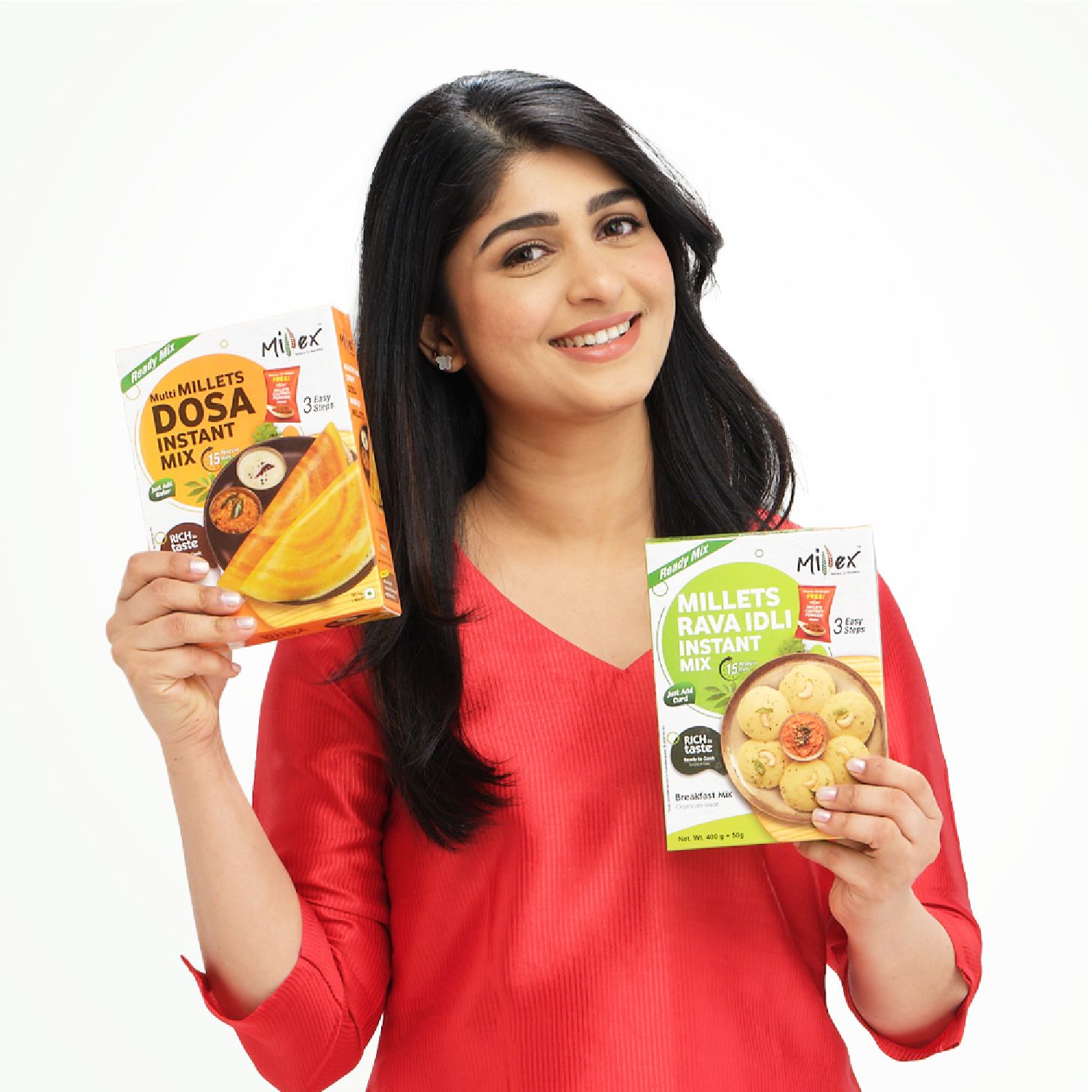List of various millets with their approximate glycemic index (GI) values
1. Little Millet : 52.11
2. Kodo : 52.7
3. Foxtail : 50 - 60
4. Barnyard : 68
5. Proso: 52.7
6. Finger Millet : 54 - 68
7. Pearl millet : 54
7 Best Low Glycemic Millets for Stable Blood Sugar Levels
People are increasingly opting for healthier choices as an outcome of a growing interest in fitness and health, which has increased the demand for millet in the market. There are various indications that "millets" were consumed throughout the Indus Valley Civilization, making them one of the first crops to be cultivated in India.

BUY NOW
Stable Blood Sugar Levels: Best Food for Ragi Dosa
Ragi dosa is a nutritious choice for maintaining stable blood sugar levels. Rich in fiber and low in glycemic index, ragi helps in slow glucose release, preventing spikes. It's an excellent meal option for diabetics and health-conscious individuals.
Start your day with these 10 diabetes-friendly breakfasts that are both nutritious and delicious! Packed with fiber, protein, and low-GI ingredients, these meals help keep blood sugar steady and taste amazing.
Very few Indians are aware of the health advantages and nutritional significance of millets, which are referred to as "Nutri-Cereals" due to their high nutritional value and ability to prevent and improve a number of chronic conditions. With over 41% of the world's total millet production, India leads the world in this area (2020).
Millets are a nutritious and sustainable crop that can flourish in challenging conditions. They are especially good for diabetics as they have a lower glycemic index than regular grains, which helps in controlling blood sugar levels. If you are looking for a health mix with millet that has a low glycemic index, Millex Millet Health Mix with out Churnam could be the right choice. Here is the list of millets added to Millex Millet Health Mix:
- Little Millet
- GI Score: 52.11
- Implication: With a medium GI, little millet is a balanced choice for regular consumption.
With its slow-digesting carbohydrates and dietary fibre that delay the release of glucose into the bloodstream, little millet is a low-glycemic index cereal that helps regulate blood sugar levels. Because of its high content of fibre, protein, and complex carbohydrates, it is a good option for those who have diabetes. It also has substantial levels of B vitamins and iron.

BUY NOW
Little millet helps with weight loss with nutrient-dense, complex carbohydrates. Also, they're quite simple to include in your existing diet. Little millet is an excellent addition to the diets of people who exercise often because it is non-acid-producing and allergy-free.
High in protein, fibre, vitamin B, iron, zinc, and magnesium, little millet is a nutrient-dense food. In eastern India, little millet is widely cultivated and utilized in various recipes such as khichdi and upma.
- Kodo
- GI Score: 52.7
- Implication: Kodo millet has a medium GI and is suitable for most individuals.
Kodo millets was first cultivated approximately 3000 years ago in India. The Kodo millet grain has a colour range of light red to dark grey. It has the highest known tolerance to drought among all the millets that are accessible, and because it yields a large amount of grain quickly, it has significant economic worth.
It's grown extensively in Madhya Pradesh, Tamil Nadu, Karnataka, Gujarat, and Chhattisgarh, India. Good quality dishes and beverages are made from Kodo millet. Kodo millets offer many health advantages in addition to their culinary and financial advantages.
It includes calcium, iron, and phosphorus along with vitamins like riboflavin and niacin. Kodo millets also contain antioxidants. From the traditional Millet Idli & Dosa to Upma, Poha, and Pongal, there are many breakfast recipes that use kodo millets.
- Foxtail
- GI Score: 50-60
- Implication: Foxtail millet, with its low GI, is beneficial for blood sugar management.
For millennia, foxtail millet also called as "Thinai" has been an essential component of many cultures' diets. In Karnataka, Andhra Pradesh, Maharashtra, and Tamil Nadu, they are extensively farmed. Beyond its potential to alleviate diabetes, foxtail millet is a nutrient-dense food that is rich in dietary fiber, protein, vitamins, and minerals.
Foxtail millet is unique as it has a low glycemic index (GI). This indicates that, in contrast to high-GI foods, it raises blood sugar levels gradually, helping in the maintenance of stable blood sugar levels and avoiding spikes that can be harmful to people with diabetes.
Proteins, carbohydrates, minerals like phosphorus, calcium, magnesium, and salt, as well as vitamins A and E, are abundant in foxtail millet. The flavour of foxtail millets is nutty and sweet, and they are used to make rice flour, ready-to-eat meals, and fast meals.
- Barnyard
- GI Score: 68
- Implication: To maintain blood glucose levels, barnyard millet is a reasonable choice with low GI.
Barnyard millet is a unique variety of millet that is packed with nutrients and is gluten-free. It's also known as "sama" grain and has become increasingly popular in recent years because of its many health advantages. This age-old grain is indigenous to India and has long been a mainstay of customary meals.
Its low GI means that consuming barnyard millet won't cause blood sugar levels to rise too rapidly after consumption. Given that meals with a low GI are beneficial for regulating blood sugar levels, barnyard millet is a smart option for anyone with diabetes or seeking to regulate their blood sugar levels.
With significant concentrations of iron, calcium, magnesium, phosphorus, and vitamin B, barnyard millet is an extremely nutrient-dense ingredient for your meals. Barnyard millet has a sweet flavour and is easy to cook.
- Proso
- GI Score: 52.7
- Implication: With a medium GI, Proso Millet is a good choice for regular consumption.
Proso is predominantly an Indian millet variety that was a commonly farmed crop. It belongs to the small millet group, often known as minor millet. Because of its exceptional drought tolerance, lowest water demand, and ability to flourish in the harshest conditions, this farmer-friendly grain is also known as a lazy farmer crop. It is nutty, sweet, and full of nutrients.
The glycemic index is low for proso millet, which means that sugars are absorbed and digested more slowly. Those who have diabetes, in particular, may benefit from this for controlling their blood sugar levels. This gluten-free grain contains considerable amounts of vitamin B3, fatty acids, protein, and healthful carbohydrates.
It also has vital minerals, including magnesium, manganese, and phosphorus, along with polyphenols. Proso millet flour is also a high-quality source of fibre. It can be used to make a variety of kid-friendly foods, including porridge, khichdi, upma, and soups, due to its culinary adaptability, which provides a healthy dinner alternative.
- Finger Millet
- GI Score: 54 to 68
- Implication: Ragi or finger millet is an excellent choice to manage blood sugar levels and overall health.
Ragi, or finger millet, is planted throughout Africa and India. Karnataka produces more than half of the crop yield, making it a significant crop in South India. The seeds of finger millet, which belongs to the Gramineae family, can be purple, red, or brown in colour.
This crop can be grown in a variety of geographical locations and can tolerate harsh weather. It has a lot of calcium, fibre, carbohydrates, fat, proteins, and other nutrients, including vitamins and minerals. With its high fibre content and low glycemic index, ragi flour is an excellent choice for diabetic management. Ragi flour does not immediately create a surge in blood sugar levels after consumption, compared to other grains and flour.
This characteristic can assist in reducing blood sugar increases and manage gestational diabetes. Due to its high fiber and polyphenol content, finger millet, is a gluten-free millet that is especially good for people with diabetes. You can create porridge, rotis, dosas, and baked products like pancakes and cookies with ragi flour.
- Pearl millet
- GI Score: 54
- Implication: Being a medium GI food, Pearl millet is suitable for most including those who manage their blood sugar levels.
Grown mostly in Africa and India, bajra is a highly nutritious and adaptable grain. The term "bajra" describes the edible seeds of pearl millet plants. They grow in bluish-purple, brown, yellow, gray, and white in varying colors. Often regarded as extremely nutrient-dense and adaptable grains, they have all the necessary elements needed to keep the body functioning properly.
Pearl millet barely impacts blood sugar levels because of its low glycemic index. Diabetes sufferers or those trying to control their blood sugar could find this to be extremely helpful. Its high fibre content, low glycemic index, and ability to sustain energy levels all contribute to its ability to control blood sugar. Pearl millet flour is a nutritious alternative to refined grain when it comes to making rotis, flatbreads, and porridge.
Final thoughts
Millets are a great choice for anyone trying to control their blood sugar levels because of their moderate to low glycemic index. So, eating more millet and high-fibre meals can help you better manage your diabetes.
Incorporate a high-fiber, all-natural health mix like Millex Millet Health Mix into your diet. Apart from the millets mentioned above, the Millex Healthy Millet Mix is a traditional blend of 30 varieties of natural ingredients, including pulses, dry fruits, millets, cereals, seeds, nuts, and spices. It simply dissolves, making it easy to incorporate into your daily diet.
which millet has lowest glycemic index?
Finger millet (ragi) has one of the lowest glycemic indexes (GI) among millets, typically ranging between 50 and 55. This low GI makes it a great option for managing blood sugar levels, especially for individuals with diabetes. Additionally, ragi is rich in dietary fiber, calcium, and antioxidants, offering various health benefits while helping maintain stable energy levels. Other millets like foxtail millet and barnyard millet also have relatively low GIs, but finger millet is often preferred for its nutritional profile and versatility in cooking.






